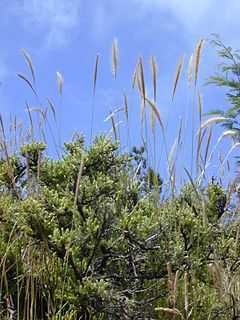Dichelachne crinita
| Dichelachne crinita | |
|---|---|
 | |
| Longhair Plume Grass | |
| Scientific classification | |
| Kingdom: | Plantae |
| (unranked): | Angiosperms |
| (unranked): | Monocots |
| (unranked): | Commelinids |
| Order: | Poales |
| Family: | Poaceae |
| Genus: | Dichelachne |
| Species: | D. crinita |
| Binomial name | |
| Dichelachne crinita (L.f.) Hook.f. | |
Dichelachne crinita , commonly known as the longhair plume grass, is a type of grass found in Australia, New Zealand and islands of the Pacific Ocean. It is often seen on sandy soils near the sea as well as woodlands. The flowering panicles are open and feathery at maturity. The grass may grow up to 1.5 metres (5 ft) tall. Crinita, the specific epithet, is derived from Latin (hairy).[1]
Taxonomy
Carolus Linnaeus the Younger described the longhair plume grass in his Supplementum Plantarum in 1781 as Anthoxanthum crinitum. Crinita is derived from the verb crinio "I cover with hair" and refers to the hairy panicles. Joseph Dalton Hooker gave it its current name in 1853.[2] Longhair plumegrass is the common name in Australia,[3] while clovenfoot plumegrass is a name recorded in America.[4]
Description
The longhair plume grass is a tufted perennial plant which can reach 1.5 m (5 ft) high. The flowers are roughly oblong-shaped or cylindrical panicles and appear in spring.[5]
Distribution and habitat
The longhair plume grass is native to all states of Australia, New Guinea, Norfolk Island, the Kermadec Islands and New Zealand. It is unclear whether it is native or naturalised on Lord Howe Island.[2] It has become naturalised on Maui in the Hawaiian Islands.[6] It grows on sandy or sandstone-based soils.[5]
Within the Sydney region, it is found in grassland to open forest communities, associated with woodland trees such as smooth-barked apple (Angophora costata), Sydney peppermint (Eucalyptus piperita), silvertop ash (E. sieberi) and red bloodwood (Corymbia gummifera), in scrub with coastal banksia (Banksia integrifolia) and broad-leaved apple (Angophora subvelutina).[7] It is a component of the Endangered Eastern Suburbs Banksia Scrub,[8] and shale/sandstone transition forest.[9]
In South Australia, it is associated with such trees as drooping sheoak (Allocasuarina verticillata), pink gum (Eucalyptus fasciculosa), sugar gum (E. cladocalyx), messmate (E. obliqua), and shrubs such as golden wattle (Acacia pycnantha) and peach heath (Lissanthe strigosa).[10]
References
- ↑ Les Robinson - Field Guide to the Native Plants of Sydney, ISBN 9780731812110 page 269
- ↑ 2.0 2.1 "Dichelachne crinita". Flora of Australia Online. Department of the Environment and Heritage, Australian Government.
- ↑ "Dichelachne crinita". Australian Plant Name Index (APNI), IBIS database. Centre for Plant Biodiversity Research, Australian Government.
- ↑ Natural Resources Conservation Service. "Plants Profile - Dichelachne crinita (L. f.) Hook. f. clovenfoot plumegrass". USDA. Retrieved 23 May 2012.
- ↑ 5.0 5.1 New South Wales Flora Online: Dichelachne crinita by S. W. L. Jacobs & K. L. McClay, Royal Botanic Gardens & Domain Trust, Sydney, Australia.
- ↑ "Checklist Query Results". Flora of the Hawaiian Islands. Smithsonian Institution. 2012. Retrieved 23 May 2012.
- ↑ Benson, Doug; McDougall, Lyn (2005). "Ecology of Sydney Plant Species Part 10: Monocotyledon families Lemnaceae to Zosteraceae". Cunninghamia 9 (1): 16–212.
- ↑ NSW Department of Environment & Heritage (February 2004). "Eastern Suburbs Banksia Scrub Endangered Ecological Community Recovery Plan". Department of Environment & Heritage, New South Wales Government. Retrieved 23 May 2012.
- ↑ NSW Scientific Committee (28 February 2011). "Shale/sandstone transition forest - endangered ecological community listing". Department of Environment & Heritage, New South Wales Government. Retrieved 23 May 2012.
- ↑ John Peter Jessop, Gilbert Roelof Maria Dashorst, Fiona M. James (2006). Grasses of South Australia: An Illustrated Guide to the Native and Naturalised Species. Wakefield Press. p. 40. ISBN 1862546940.